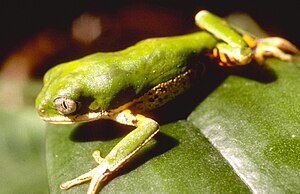Phyllomedusa hypochondrialis
| Phyllomedusa hypochondrialis | ||||||||||||
|---|---|---|---|---|---|---|---|---|---|---|---|---|

Phyllomedusa hypochondrialis |
||||||||||||
| Systematics | ||||||||||||
|
||||||||||||
| Scientific name | ||||||||||||
| Phyllomedusa hypochondrialis | ||||||||||||
| ( Daudin , 1800) |
Phyllomedusa hypochondrialis belongsto the genus of the Makifrogs ( Phyllomedusa )within the family of the Phyllomedusidae .
features
Females of Phyllomedusa hypochondrialis reach a body length of up to 5 cm, males remain smaller at 4 to 4.5 cm, and the females are a bit fuller. The body is generally slender, the head is massive, and the abdomen tapers backwards. The large, round eyes are silvery gray and have a rounded or vertically slit pupil. The first two fingers or toes are facing each other, so hands and feet can grip easily. The smooth back is usually brown at night and bright green during the day. The insides of the legs are striped orange and black, the belly is also strong or pale yellow and black striped or speckled. The tadpoles of the species Phyllomedusa azurea have a blue tail.
Way of life
Phyllomedusa hypochondrialis is nocturnal and climbs in the vegetation of its habitat. During the day it hides well camouflaged on leaves with its legs drawn up, at night it hunts various insects , such as small crickets and flies , which are captured while jumping. To mate shortly after the start of the rainy season, the male clasps a female for several days before 40 to 80 (maximum 120) eggs are laid above the water in leaves rolled up like a bag and fertilized in the process. Several clutches can be created. After about 8 to 10 days, the tadpoles hatch and fall into the water, where they develop into small frogs within 7 to 10 weeks. In captivity, Phyllomedusa hypochondrialis can live to be around 7 years of age.
distribution
Phyllomedusa hypochondrialis occurs in northern and eastern South America in Venezuela , Suriname , Guiana and Brazil . In central South America, its distribution area borders on the eastern Andes . Habitats are the bank vegetation of standing water and pools in forest and savannah regions with pronounced rainy and dry seasons.
Systematics
The first description of phyllomedusa hypochondrialis was made in 1800 by the French zoologist François-Marie Daudin under the scientific name Hyla hypochondrialis .
Subspecies
- Phyllomedusa hypochondrialis hypochondrialis ( Daudin 1800)
- Phyllomedusa hypochondrialis azurea ( Cope , 1862)
Terrariums
Phyllomedusa hypochondrialis should be kept at temperatures between 24 and 28 ° C (locally up to 30 ° C) and a relative humidity between 60 and 80% (at night 90 to 100%) in a lush, high terrarium with large-leaved plants, climbing opportunities, roots and larger Water part are kept. Since the animals in captivity are susceptible to bacterial and fungal infections, extreme hygiene must be observed.
swell
- Eugéne Bruins: Illustrated Terrarium Encyclopedia. Doerfler-Verlag, ISBN 978-3-89555-423-0 , pp. 284-285.
- Uwe Dost: The cosmos book of terraristics. Kosmos Verlag, ISBN 3-440-10129-0 .
Web links
- Pithecopus hypochondrialis inthe IUCN Red List of Threatened Species 2013.1. Posted by: Claudia Azevedo-Ramos, Débora Silvano, Norman Scott, Lucy Aquino, Enrique La Marca, Jorge Céspedez, Esteban Lavilla, 2008. Retrieved October 24, 2013.